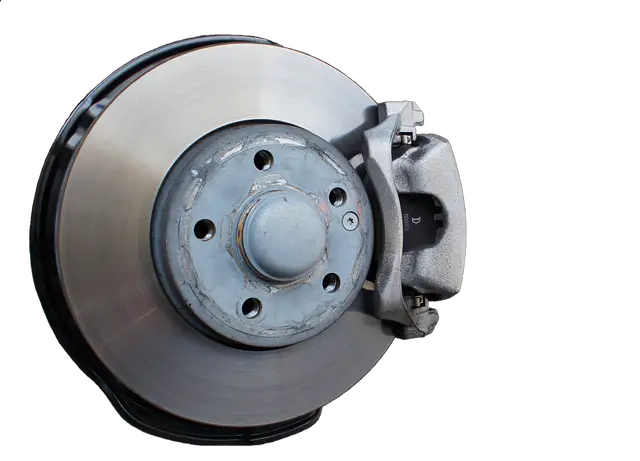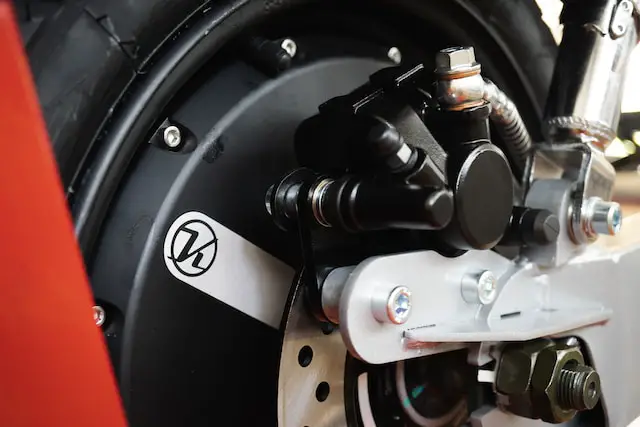Brake pads are responsible for providing the friction needed to stop the wheels from rotating, while brake discs help dissipate heat and prevent warping.
What are brake pads?
(Image by Ralph from Pixabay )

Brake pads are the part of your brakes that make contact with the brake rotor, providing the friction necessary to stop your vehicle. They are made of a wear-resistant material, typically metal, ceramic, or semi-metallic, that is bonded to a backing plate. The backplate provides stability and support for the pad during operation.
As brake pads wear down, it becomes thinner and their ability to stop your car gradually decreases. When the pad gets too thin, it will need to be replaced. Replacing your brake pads is typically a fairly simple process that can be completed at home with basic hand tools.
What are brake discs?
(Photo by Kumpan Electric on Unsplash )

Brake discs (or rotors) are the other main component of your vehicle’s braking system. The discs are mounted on the wheels and rotate along with them. When you press the brake pedal, brake fluid is forced into calipers which grasp the disc and slow it down.
Like brake pads, brake discs wear down over time and will eventually need to be replaced. However, because they are made of metal they can usually be resurfaced rather than replaced outright. Resurfacing involves machining off a small layer of metal from the disc surface to renew it.
Most cars have either four-wheel or front-wheel disc brakes. In a four-wheel disc brake system, each wheel has its own caliper and disc. In a front-wheel disc brake system, the two front wheels share a single caliper, while each of the rear wheels has its own caliper and disc.
Disc brakes are more effective than drum brakes because they dissipate heat better and have less chance of fading under heavy use. Disc brakes also last longer than drum brakes and require less maintenance.
The difference between brake pads and discs
Brake pads and discs both serve the same purpose of slowing down or stopping a vehicle. The main difference between the two is that brake pads are made of a softer material, while discs are made of a harder material. Brake pads are typically made of metal, ceramic, or rubber, while discs are usually made of metal or ceramic.
Discs typically last longer than pads, but they can also be more expensive to replace. Pads need to be replaced more often because they wear down faster due to their softer material. When replacing either brake pad or disc, it is important to get ones that are compatible with your vehicle and match the other brake components.
Brake pads Vs. Brake discs – Key differences
Function: Brake pads are the friction material that presses against the brake discs to generate the necessary friction and slow down or stop the vehicle. Brake discs, also known as rotors, provide a surface for the brake pads to grip onto and dissipate heat.
Material: Brake pads are typically made of various composite materials that have high friction properties and can withstand heat generated during braking. Brake discs are usually made of cast iron, but they can also be made from other materials like carbon composite for high-performance applications.
Location: Brake pads are installed in the brake calipers and directly contact the brake discs. The brake discs, on the other hand, are mounted on the wheel hubs and rotate with the wheels.
Wear and Tear: Brake pads are subject to wear and need periodic replacement due to friction against the rotating brake discs. Brake discs also experience wear over time but generally have a longer lifespan compared to brake pads.
Maintenance: Brake pads are more commonly replaced during routine brake service, while brake discs may require replacement if they become excessively worn, damaged, or warped.
Contribution to Braking Performance: Both brake pads and brake discs play crucial roles in braking performance. The quality and condition of brake pads directly affect stopping power and braking efficiency, while the design and condition of brake discs influence heat dissipation and resistance to warping.
Understanding these differences is essential for maintaining and optimizing the braking system’s performance, ensuring safe and reliable braking in vehicles.
How to know when you need new brake pads or discs
It’s important to know when your brake pads or discs need to be replaced. Depending on your driving habits, you may need to replace your brake pads more frequently than your discs. Here are some signs that it’s time for new brake pads or discs:
- Your brakes are making noise (squealing or grinding)
- Your brakes are vibrating
- Your car is pulling to one side when you brake
- You have to press the pedal further down than usual to engage the brakes
If you’re experiencing any of these issues, it’s time for new brake pads or discs. Be sure to consult with a qualified mechanic to ensure that you’re getting the right parts for your car.
The advantages and disadvantages of brake pads
Advantages of brake pads:
Efficient Braking: Brake pads provide high friction against the brake discs, allowing for effective and quick deceleration or stopping of the vehicle.
Consistent Performance: Well-maintained brake pads offer consistent braking performance, providing a reliable and predictable response when applied.
Heat Dissipation: Brake pads are designed to dissipate heat generated during braking, preventing excessive heat buildup that could affect braking performance or lead to brake fade.
Cost-effective: Brake pads are generally more affordable to replace compared to other components of the braking system, such as brake discs.
Disadvantages of brake pads:
Wear and Replacement: Brake pads wear down over time and need periodic replacement. This regular maintenance can be an inconvenience and an additional cost for vehicle owners.
Dust and Noise: Some brake pads can produce dust particles during braking, which may accumulate on the wheels and require cleaning. Certain brake pad materials can also generate noise or squealing when in use, although advancements have been made to minimize this issue.
Compatibility Issues: With a wide variety of vehicles and brake systems available, ensuring the right brake pads for a specific vehicle model and application is crucial. Using incorrect or incompatible brake pads can result in subpar braking performance or damage to the braking system.
Despite these disadvantages, brake pads play a vital role in vehicle safety and are a necessary component of any braking system. Regular inspection, maintenance, and choosing high-quality brake pads can help mitigate potential drawbacks and ensure optimal braking performance.
The advantages and disadvantages of brake discs
Advantages of brake discs:
Heat Dissipation: Brake discs are designed to dissipate heat efficiently, allowing for consistent braking performance even during prolonged or intense braking situations.
Durability: Brake discs are typically made of durable materials, such as cast iron or carbon composite, which can withstand high temperatures and resist wear, resulting in longer lifespan compared to brake pads.
Reduced Brake Fade: Brake discs’ ability to dissipate heat effectively helps minimize brake fade, a condition that occurs when repeated or prolonged braking causes a decrease in braking performance due to excessive heat buildup.
Compatibility and Standardization: Brake discs are often standardized components, making them readily available and compatible with a wide range of vehicles, simplifying maintenance and replacement.
Disadvantages of brake discs:
Higher Cost: Brake discs tend to be more expensive to replace compared to brake pads, which can impact the overall maintenance cost of the braking system.
Heavier Weight: Brake discs contribute to the overall weight of the vehicle, which may have a slight impact on fuel efficiency, especially in high-performance vehicles.
Potential for Warping: In extreme conditions or due to improper use, brake discs can warp, causing vibration or pulsation during braking. Warped discs may require resurfacing or replacement for optimal performance.
Limited Serviceability: Unlike brake pads, which can be easily replaced, brake discs may require specialized tools or equipment for resurfacing or replacement, making maintenance more complex.
Despite these disadvantages, brake discs are integral to the braking system’s performance and safety. Regular inspection, proper maintenance, and using high-quality brake discs can help mitigate potential drawbacks and ensure reliable and efficient braking.
Featured Image By Benjamin Brunner on Unsplash








